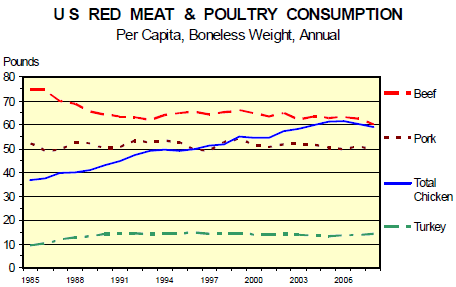



CME: Decline in Meat and Poultry Demand?
US - CME's Daily Livestock Report for 12 February 2009.Yesterday’s release of final 2008 export figures for the US meat and poultry sectors allows us to also make final estimates of US total and per capita consumption of meat and poultry. If that statement strikes you as a bit odd, welcome to the club. The fact is, though, that we do not directly measure the consumption of agricultural products in general or meat and poultry in particular. Meat and poultry consumption is simply the amount of supply whose eventual disposition we cannot otherwise explain. It is actually:
Disappearance = Beginning Stocks + Production + Imports– Exports—Ending Stocks.
USDA measures all of the numbers on the right-hand side of the equation and we simply assume that all of disappearance is consumed in one way or another. Carcass weight disappearance is adjusted for estimated other usage (primarily pet food) to arrive at retail weight consumption which is the best estimate of how much product US consumers BUY. Retail weight consumption is adjusted for bone, waste fat and skin removal to arrive at boneless equivalent consumption, the best estimate of how much U.S. consumers EAT.
Graphs of per capita consumption on a retail and boneless equivalent basis appear below. Both consumption measures declined in 2008 for beef, pork and chicken. Both increased just slightly for turkey. Larger exports were an important factor in driving down US beef, pork and chicken consumption last year as less product remained available to US consumers. Does this mean that demand declined? Not necessarily. Lower availability could go with higher demand if prices increase by an amount greater than would be expected from move along a negatively sloped demand curve. That expected price increase, of course, can be computed using an estimate of the elasticity of demand — precisely the computations that the economists at the University of Missouri do each month in arriving at their demand indexes. Retail price increases in 2008 were not large enough to support a conclusion that demand for any of the species had remained constant. The moral to the story: Little can be concluded from either the change in consumption or the change in price alone. They must be considered together!


USDA’s Economic Research Service (ERS) released on Wednesday its estimates of Farm Income and Costs for 2009. The agency expects net farm income in 2009 to be $71.2 billion, 20 per cent lower than in 2008 but still 9 per cent higher than the average of the previous 10 years. Incomes of livestock operations are projected to fall in 2009, primarily due to world economic events and their impacts on both receipts and production costs. Dairy farms are forecast to have a 71 per cent reduction in net cash income in 2009 due largely to a drop in average milk prices to $12/cwt, $7 lower than the record $19/cwt in 2007. That drop in revenue will more than offset a 7 per cent decline in costs. Other livestock enterprises, though, are expected to fare better in 2009 than in 2008. Net cash income of beef cattle producers is forecast to rise by 23 per cent from 2008 though it will still be well below the levels of 2003-07. Average net incomes for pork and chicken producers are expected to increase by 1.5 per cent and 12.2 per cent, respectively. That estimate for pork producers looks quite low to us given the dismal economic performance of hog farms in 2008 — averaging $20/hd losses.








